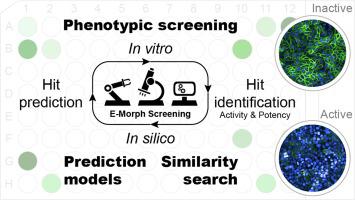Environment International ( IF 10.3 ) Pub Date : 2021-10-28 , DOI: 10.1016/j.envint.2021.106947 Saskia Klutzny 1 , Marja Kornhuber 2 , Andrea Morger 3 , Gilbert Schönfelder 4 , Andrea Volkamer 3 , Michael Oelgeschläger 1 , Sebastian Dunst 1

|
Background
Exposure to environmental chemicals that interfere with normal estrogen function can lead to adverse health effects, including cancer. High-throughput screening (HTS) approaches facilitate the efficient identification and characterization of such substances.
Objectives
We recently described the development of the E-Morph Assay, which measures changes at adherens junctions as a clinically-relevant phenotypic readout for estrogen receptor (ER) alpha signaling activity. Here, we describe its further development and application for automated robotic HTS.
Methods
Using the advanced E-Morph Screening Assay, we screened a substance library comprising 430 toxicologically-relevant industrial chemicals, biocides, and plant protection products to identify novel substances with estrogenic activities. Based on the primary screening data and the publicly available ToxCast dataset, we performed an in silico similarity search to identify further substances with potential estrogenic activity for follow-up hit expansion screening, and built seven in silico ER models using the conformal prediction (CP) framework to evaluate the HTS results.
Results
The primary and hit confirmation screens identified 27 ‘known’ estrogenic substances with potencies correlating very well with the published ToxCast ER Agonist Score (r = +0.95). We additionally detected potential ‘novel’ estrogenic activities for 10 primary hit substances and for another nine out of 20 structurally similar substances from in silico predictions and follow-up hit expansion screening. The concordance of the E-Morph Screening Assay with the ToxCast ER reference data and the generated CP ER models was 71% and 73%, respectively, with a high predictivity for ER active substances of up to 87%, which is particularly important for regulatory purposes.
Discussion
These data provide a proof-of-concept for the combination of in vitro HTS approaches with in silico methods (similarity search, CP models) for efficient analysis of large substance libraries in order to prioritize substances with potential estrogenic activity for subsequent testing against higher tier human endpoints.
中文翻译:

使用 E-Morph 筛选分析结合计算机预测对环境雌激素进行定量高通量表型筛选
背景
接触干扰正常雌激素功能的环境化学物质会导致不利的健康影响,包括癌症。高通量筛选 (HTS) 方法有助于有效识别和表征此类物质。
目标
我们最近描述了 E-Morph Assay 的开发,它测量粘附连接处的变化,作为雌激素受体 (ER) α 信号活性的临床相关表型读数。在这里,我们描述了它在自动化机器人 HTS 中的进一步开发和应用。
方法
使用先进的 E-Morph Screening Assay,我们筛选了一个包含 430 种毒理学相关工业化学品、杀菌剂和植物保护产品的物质库,以识别具有雌激素活性的新物质。根据初筛数据和公开可用ToxCast数据集,我们进行了在 硅片上的相似性搜索,以确定具有潜在的雌激素活性的其它物质进行后续命中扩张筛选,筑了七座在 硅片使用共形预测ER模型(CP)评估 HTS 结果的框架。
结果
主要和命中确认筛选确定了 27 种“已知”雌激素物质,其效力与公布的 ToxCast ER 激动剂评分 (r = +0.95) 非常相关。我们另外检测到的电位的小说“雌激素活性10种初步击中物质和用于从另一十分之九的20类似结构的物质在 芯片上预测和后续的命中膨胀筛选。E-Morph Screening Assay 与 ToxCast ER 参考数据和生成的 CP ER 模型的一致性分别为 71% 和 73%,对 ER 活性物质的预测率高达 87%,这对于监管尤其重要目的。
讨论
这些数据提供了一个验证的概念的组合在体外HTS与接近在 计算机芯片上的方法(相似性搜索,CP模型)为大型物质文库高效分析,以对较高层级的优先与潜在的雌激素活性的物质用于随后的测试人类端点。











































 京公网安备 11010802027423号
京公网安备 11010802027423号